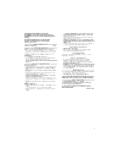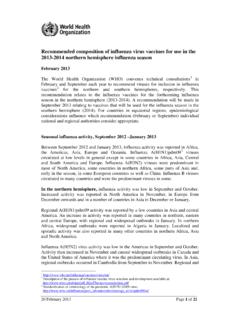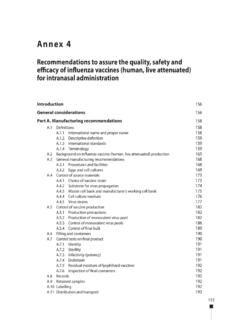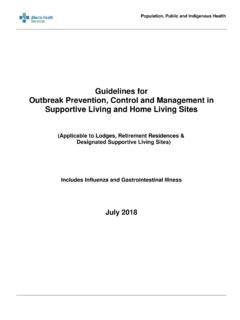Transcription of Anaesthesia and Psychiatric drugs (2) - FRCA
1 Sign up to receive ATOTW weekly - email .MICROBIOLOGY FOR ANAESTHETISTS PART 1 - THE PHARMACOLOGY OF ANTIBACTERIAL AND antiviral DRUGSANAESTHESIA TUTORIAL OF THE WEEK 1902nd AUGUST 2010Dr Lesley BromleyUniversity College LondonCorrespondence to: continuing try to answer the following questions. The answers can be found at the end of the article. following antibacterial agents infer with protein synthesis a)Amoxycillin b)Erythromycin c)Tetracycline d)Trimethoprin e)Penicillin is a)Bacteriostatic b)Active against gram positive organisms only c)Contain a beta lactam ring d)Active against Methacillin Resistant Staph Aureous (MRSA) e)Is resistant to stomach acid Aminoglycoside antibiotics a)Are well absorbed from the GI tract b)Are toxic to the liver c)Shorten the duration of neuromuscular blocking drugs d)May cause deafness e)Affect bacterial wall formationATOTW 190 The pharmacology of antibiotic and antiviral drugs 02/08/2010 Page 1 of 7 Sign up to receive ATOTW weekly - email.
2 INTRODUCTION Antibacterial and antiviral drugs includes the antibiotics, which are drugs produced by micro-organisms and chemotherapeutic agents that are chemically synthesised. Antibacterial drugs may be used to treat infection, or may be given prophylactically to prevent the development of infection. This latter use is common in some forms of surgery and anaesthetists are often responsible for giving these drugs . Therefore it is important to understand their pharmacology and the nature of any interactions with other drugs used in Anaesthesia . Antibacterial drugs bring about their action by one of two mechanisms. They can limit bacterial growth, a bacteriostatic effect, slowing growth and allowing the immune system to remove the bacteria from the body. Alternatively they cause bacterial death, a bacteriocidal effect. At the same time, the host cells are undamaged by the drug. With antiviral drugs the virus replicates with in the host cells, so drugs are required to selectively inhibit the metabolic processes specific to viral replication.
3 This can only be achieved to a limited drugs MECHANISMS OF ACTIONI nhibitors of cell wall drugs act on bacteria that have a cell wall consisting of a lattice work of murein. They prevent the cross linkage of the molecules that make up the lattice. Mammalian cells do not have these rigid cell walls so are 1: Bacterial cell wall structureDrugs in this group include:PenicillinsThis is the oldest group of drugs and obtained from a mould, penicillium notatum. They inhibit the enzyme transpeptidase that forms the lattice cross links. Their action is bacteriocidal, because the defects in the murein wall allow the bacteria to swell and burst. The penicillin molecule contains a beta-lactam ring, which confers its anti-transpeptidase activity. In this original form it has a narrow antibacterial spectrum, confined to gram-positive bacteria, gram negative cocci and spirochetes. Many gram negative bacteria are unaffected by penicillin. Some bacteria produce a penicillinase (beta-lactamase) which cleaves the beta-lactam ring and confers penicillin resistance on the 190 The pharmacology of antibiotic and antiviral drugs 02/08/2010 Page 2 of 7 Sign up to receive ATOTW weekly - email.
4 Penicillins are well tolerated, but at high doses are neurotoxic and convulsions may be seen with sudden high concentrations in the brain. This is due to GABA antagonism and can occur after intrathecal or high dose intravenous manipulation of the penicillin molecule has been performed to give better bioavailability, penicllinase resistance and a wider spectrum of activity: Flucloxacillin is penicillinase resistant and orally absorbed. The aminopenicillin amoxicillin has a wider spectrum being active against many gram negative organisms. It is often combined with clavulanic acid, a beta-lactamase inhibitor that prevents the action of penicillinase. Carboxypenicillins such as carbicillin, ticarcillin and acylaminopenicillins such as mezclocillin and azlocillin have a very broad spectrum but are not acid stable, or penicillinase resistant. They are active against pseudomonas species. Piperacillin is often combined with a beta-lactamase inhibitor, tazobactam.
5 CephalosporinsThese drugs also come from fungi and contain the beta-lactam group in their molecules. These are classified in generations. The earliest first generation cephalosporin was cephalexin, which is a broad-spectrum oral cephalosporin with activity largely against gram positive bacteria. It is bacteriosidal. Subsequent developments have produced a wider spectrum of activity. The second generation includes cefuroxime wich has a broader spectrum including many gram negative species. Resistance to second generation cephalosporins is increasing. Third generation includes cefotaxime and ceftazidime, these have increased activity against gram negative species. They penetrate the CNS and are useful to treat meningitis caused by meningococci, pneumococci and H. influenzae. The fourth generation consists of one drug cefepime, which is active against pseudomonus aeroginosa. The fifth generation, soon to be launched, is called ceftobiprol is active against methicillin resistant staphlococcus aureus.
6 (MRSA)VancomycinThis drug is a glycopeptide and structurally unlike any other antibacterial drug. It inhibits cell wall production but also affect cell synthesis. It is highly polar and not absorbed from the gut. As a result it has been used to treat pseudomembranous enterocolitis caused by clostridium difficile. Resistance to this drug appears to be of tetrahydrofolate synthesisTrimethoprin and co-trimoxazoleThese two drugs inhibit the conversion of dihydrofolate to tetrahydrofolic acid by blocking dihydrofolate reducatase. Tetrahydrofolic acid is a co-enzyme in the synthesis of purine bases and thymidine. These are required for the synthesis of DNA and RNA. The effect is to limit cell growth. They are therefore basteriostatic. Trimethoprin has selectivity for bacterial dihydrofolate reductase, but can affect human folate metabolism, occasionally causing bone marrow depression. It is usually combined with a sulphonamide sulfamethoxazole, which also affects folate metabolism but at a different step in the pathway.
7 The combined preparation is more effective than either alone, and example of pharmacological synergy. Resistance to these drugs is , acts by the same mechanism and is used prophylactically and as chemotherapeutic agent in leprosy, toxoplasmosis and 190 The pharmacology of antibiotic and antiviral drugs 02/08/2010 Page 3 of 7 Sign up to receive ATOTW weekly - email .Inhibitors of DNA functionMetronidazole and rifampicinMetronidazole damages DNA by complex formation with the DNA molecule and strand breakage. In anaerobic organisms it is converted to a reactive metabolite which attacks the DNA. It is bacteriocidal and also anti-protozoal and anti-amoebic. The drug is potentially mutagenic, tetratogenic and should be avoided in pregnancy and prevents RNA transcription and is bactericidal against mycobacteria species as well as gram positive and gram negative organisms. Resistance develops and it is reserved for the treatment of TB and leprosy.
8 Inhibitors of Protein SynthesisFigure 2: Mechanisms of action of the Protein synthesis inhibitorsTetracyclines, aminoglycosides, chloramphenicol and and aminoglycoside drugs both alter transcription of RNA and creation of proteins. They bind to ribosomes and prevent the initiation of protein synthesis. Tetracyclines are broad spectrum and bacteriostatic. The aminoglycosides induce the production of false proteins and are bacteriocidal. They are active against gram negative orgamisms. Gentamicin is not active against anaerobes because oxygen is needed for its uptake into the bacterial cell. It is synergistic with the beta-lactam containing antibiotics. The aminoglycosides are taken up in the tubular cells of the kidney and can cause renal tubular damage. They are also concentrated in the endolymph of the inner ear and can cause damage to the 8th cranial nerve. The toxic effects are associated with high peaks of serum concentration.
9 Gentamicin levels may need to be monitored in renal impairment. If bolus doses are given they should be injected slowly over 5 minutes to prevent the peak concentration rising into the toxic inhibits peptide sythetase, it has a bacteriostatic effect. It is toxic to bone marrow, particularly in babies. It is used in bacterial inhibits transfer RNA preventing the assembly of proteins. It is active against gram positives but most gram negative organisms are resistant to it. Clarithromycin is a derivative with better acid resistance and bioavailability. Clindomycin is a semisynthetic analogue that is well absorbed orally. These drugs are 190 The pharmacology of antibiotic and antiviral drugs 02/08/2010 Page 4 of 7 Sign up to receive ATOTW weekly - email .Interactions between antibiotic drugs and anaesthetic can be pharmacokinetic or pharmacodynamic. Many antibacterial agents are highly protein bound and will displace other drugs , thereby affecting their toxicity and metabolism.
10 drugs which suppress synthesis of protein can affect the metabolism of other drugs . Classically gentamicin and the other aminoglycoside antibiotics prolong the duration of action of muscle relaxant drugs . They may also worsen symptoms in myasthenia drugs MECHANISMS OF ACTIONIn the last ten years the number of available antiviral drugs has increased from 5 to nearly 40. The mechanism of action of these drugs is aimed at various targets in the viral replication process. To replicate the virus needs to: 1)Enter the cell and separate from its protein coat2)Interact with the cell DNA and produce viral RNA3)Transcript the viral RNA into viral proteins and new )Assemble the viral DNA and proteins into new viral particlesRNA viruses are simpler entities and need only replicate their own RNA and proteins for the outer major target of these drugs is an enzyme called reverse transcriptase, which is involved in the synthesis of new viral molecules.
















